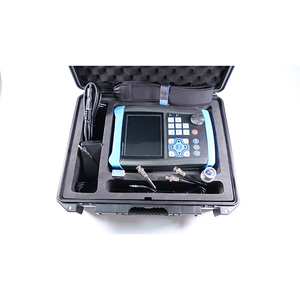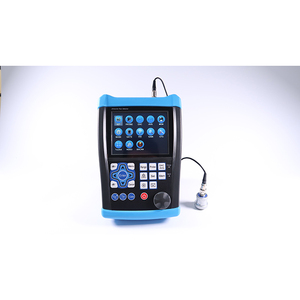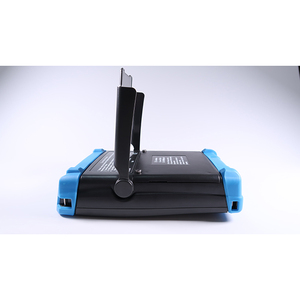
All categories
Featured selections
Trade Assurance
Buyer Central
Help Center
Get the app
Become a supplier

(1410 products available)





















There are some ultrasonic hardness tester types available in the market. These types are portable and more advanced due to the integration of analytical forms and conventional measuring techniques. People use a few of these testing device prototypes in specific industrial applications, while others, like the portable ones, are widely utilized in the quality assessment of metallic substances in various manufacturing sectors. Suppliers consider buying the following ultrasonic hardness testing equipment types in large quantities:
Manufacturers make the bench-top hardness testers like the Ultrasonic Concrete Test Hammer as permanent hardness testing laboratory equipment. Large and stable tester models have a solid base and many advanced features. For instance, the hardness measurement system can be combined with additional devices like data recording and electro-acoustic examination tools. Some models come with scanning probe or automatic depth measurement, among other features. The main advantages that hardness testers offer include:
Manufacturers make handheld hardness testers for in-field assessment and flexible use. They closely resemble typical measuring devices, and their users enjoy the fast and straightforward readings. Unfortunately, they are relatively smaller and therefore do not have the necessary strength and advanced features of bench-top hardness testers. However, some of their key advantages include:
Digital ultrasonic hardness testers employ modern digital technology to process and show the measurements. People replicate many analog systems but improve them by putting a digital screen and saving data features. That is why they are among the preferred machines considering they can convert the results faster for efficiency in testing and reporting. Some advantages of digital systems include:
Some testers available in the market combine ultrasonic methods with other hardness test techniques, such as indentation or elastic recoil. Although these systems are harder to transport, they provide thorough readings of the examined material's mechanical properties. Some of the advantages include:
Concrete test hammers are proficiently used in various industries to check the improvement phase and practical use of hardness analysis. This technique is non-destructive, so it is ideal for evaluating critical components that are subjected to high stress or wear while still preserving their functionality. A summary of the commonly used industry application follows:
The aerospace industry works with several materials, including heat-resistant alloys and titanium. The industry monitors the hardness of such components as engine parts, turbine blades, and landing gear made from these metals. Hardness control ensures that factors like weight, strength, and thermal endurance remain balanced within an acceptable limit. Aerospace sector users prefer ultrasonic concrete test hammers because they can collect data in an actual working environment and import it directly into the engineering chart without harming expensive components. Testing before fabricating parts as a final assembly completion step is also critical in this industry to fulfill safety and performance requirements.
All vehicles come with parts that should have undergone ultrasonic hardness testing, for example, engine blocks, transmission gears, shafts, and suspension components. Automotive users perform the evaluation to verify that components meet quality control standards and enhance wear resistance. They also analyze large batches to check consistent quality for economically and logistically favorable mass production. According to industry trends, Non-Destructive Testing (NDT) methods like ultrasonic testing are replacing older techniques. NLT provides good measurement flexibility while cutting down costs and saving time. Therefore, automotive manufacturers consider it an essential tool for follow-up.
Metallurgical product testers evaluate metal sheets, coils, or castings to check and record hardness. It is essential for confirming that the critical material characteristics of the metal remain unchanged after the mechanical working methods like rolling and forging. Ultrasonic hardness assessment is more preferable in this sector due to its speed, and it is also practical for large batch testing. People have also advocated for the method because of its accuracy in degree measurement and ability not to damage or change the sample surface at all. Thus, it becomes a highly effective criterion used in quality control in metal processing facilities.
Pipelines, drilling rigs, and pressure vessels are some of the hardware used in the oil and gas sectors. Ultraasonic testing evaluates the life of these key components and offers reports on wear, erosion, and resistance to environmental changes. For instance, ultrasonic technique evaluation reports show how materials respond to stresses, helping pick out likely failures before they occur. The industry NDT methods enable periodic evaluation of important factors like substance transport systems and well casings without the need to pull out or damage the samples, which comes in handy for operational efficiency and safety. Many of the hardness testers available in the market are portable; hence, they can be used in oil fields and offshore rigs, giving the correct readings on-site without taking the samples to the lab for analysis.
Suppliers looking to stock up on measuring tools need to make many important decisions on the type of measuring tools to procure. With regard to ultrasonic hardness testers, here are some key factors to consider:
When choosing the testers to stock, suppliers should consider the industries that require the evaluation in big demand. For instance, those in the aerospace and automotive industries should focus more on portable and bench-top hardness testers, while those in the construction and engineering sectors should stock combined systems. Suppliers can first research and analyze the market to know what industries are widely used and how they use the testers.
When choosing which ultrasonic hardness tester to stock, suppliers should consider measurements, calibration ranges, hardness scales, data storage capacity, and battery life. A good supplier stocks items for different customers and different uses. For the customers needing the digital ones, suppliers should get testers with memory and instant upload features. For users who use them in the field, suppliers should consider the battery life of the testers.
Suppliers must ensure the measurable products they supply are of great quality, have good repeatability and reproducibility, and are from trustworthy brands. They also ensure they stock up on spares and follow-up products.
Suppliers should strategically price products by making them favorable compared to competitors. They should be able to provide considerable discounts to bulk buyers because they normally buy in bulk. Suppliers should consider wholesale hardness tester prices to get a reseller and bulk buyer discount.
To avoid shortages and obtain the desirable model, it is crucial for the supplier to cultivate reliable relationships with the manufacturers.
Properly functioning hardness testers guarantee precise readings in this field. Follow up on the calibration and maintenance processes to achieve this. Read more about various maintenance tips below:
Avoid testing on materials that possess high elasticity or have left hardened through the testing process. These materials give distorted results, and therefore, it is best to test on samples that have low elasticity and have not been hardened.
Make proper use of the coupling agent by applying it adequately on the surface of the samples that are going to be tested in order to enjoy the benefits of ultrasonic hardness testing. Also, avoid pressure on the probe during the measurement to avoid deformation of the sample and getting distorted results.
The probes must be cleaned after testing each sample to avoid transferring residue from one sample to another, which alters the readings. Use soft cloths to wipe them for effective and accurate shots.
Normal calibrations help check if the instrument behaves properly within the defined hardness ranges. Compare the instrument against calibration standards at least once a month or more frequently when using it in demanding environments.
Since hardness testers are not heavy measuring instruments but quite delicate gadgets, special care should be taken when storing and transporting them. A hard case should be used to store them, away from moisture and extreme temperatures, as these conditions can affect the equipment.
Digital testers are often equipped with special programs to analyze and record data. Just as with any other type of electronic device, these programs should be updated to improve their performance or fix previously known errors. Check for updates from the manufacturer every so often and install them if necessary.
Many portable ultrasonic hardness testers use rechargeable batteries. The test equipment users should frequently charge the battery, and the battery should not be left undepleted for a long time. Also, they should not overexert the battery by always using it at maximum power.
Check the external parts of the tester frequently to ensure no dirt or damage has been done to them. All the external elements must be in good shape so that they do not affect the internal workings. Survey the screen, case, and buttons, and make a note of any required repairs or replacements as soon as possible so that there will be less disruption in the hardness testing.
A1: There are many important factors buyers consider when shopping for hardness testers, such as the typical hardness measurement range and the kind of materials they intend to measure. Also, they should look closely at their calibration standards because they determine the accuracy of the readings. Buyers can choose from various hardness testing equipment that suits their needs, from fixed systems for permanent testing laboratory setups to portable ones for fieldwork.
A2: The commonly made errors include not using the right preparation method, using probes with contamination, running tests on known extreme samples, and not calibrating the tester often. They can avoid the mistakes by learning about the right preparation methods and the right hardness tester procedures ahead of time and being careful to follow them throughout the testing to produce correct results.
A3: Materials with strong elastic modulus, high tensile strength, and thick density are suitable for ultrasonic hardness testing. They also have low elasticity and yield point to allow proper wave penetration without distortion.
A4: Yes, they do. Periodic calibration, cleaning, probe examination, and storage in a cool, dry place are among the maintenance a concrete tester should undergo. Also, the battery has to be monitored if it is a digital model.